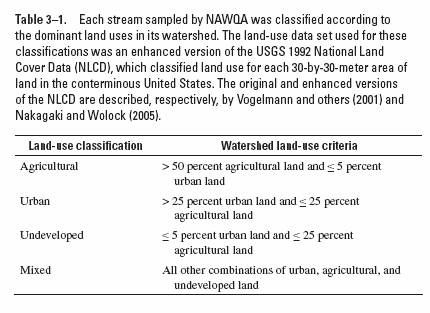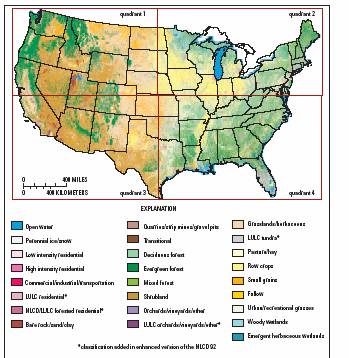The Quality of Our Nation's Waters
Pesticides in the Nation's Streams and Ground Water, 1992-2001
BACK TO previous page

How this table was made:
This table defines the national land-use classifications used to characterize stream sites sampled by NAWQA. The objective was to establish a consistent approach for national analysis. Briefly, the percentage of land area within each watershed comprised by up to 25 different land-cover types was determined using national land-cover data. The total agricultural land, total urban land, and total undeveloped land were calculated (as a percentage of total watershed area) by summing the percentages of land cover classifications fitting each of these three categories. Each site then was assigned to one of 4 national land-use classes (agricultural, urban, undeveloped, and mixed land use), depending on the amount of agricultural, urban, and undeveloped land within the watershed, using the criteria listed in this table. Ultimately, a few sites had their classifications adjusted if the land use area percentages within the watershed were substantially different from the sources of water at the stream sampling site. More detail is provided below:
- The initial determination of land use within each watershed was made using an enhanced version of the 1992 National Land Cover Data (NLCD), which classifies land use for each 30-meter-square area of land in the conterminous U.S. The original 1992 NLCD contained 21 land-cover classifications, such as low intensity residential, row crop, and deciduous forest (Vogelmann and others, 2001; U.S. Geological Survey, 1999). The 2005 version of the enhanced 1992 NLCD (NLCDe) was developed by integrating selected classifications from U.S. Geological Survey’s Land Use and Land Cover (LULC) Dataset (Fegeas and others, 1983; U.S. Geological Survey, 1998) as enhanced by Price and others (2003), with the 1992 NLCD. As described in Nakagaki and Wolock (2005) and shown below in Figure A, the NLCDe contains 25 land-cover classifications (the original 21 land-cover classifications plus 4 additional ones).

Figure A: The above map shows the “enhanced” 30-m resolution National Land Cover Data 1992 (NLCDe) for the conterminous U.S., including boundaries of the four quadrant grids. Because of limitations of the ArcInfo GRID data model, four separate quadrant grids, rather than a single grid, were generated. (From Nakagaki and Wolock, 2005).
- For each site, the percentage of the watershed corresponding to each of three aggregated land use categories, was calculated as follows:
- Total agricultural land: the sum of row crops, small grains, pasture/hay, orchards/vineyards/other, LULC orchards/vineyards/other*, and fallow.
- Total urban land: the sum of low intensity residential, high intensity residential, commercial/industrial/transportation, LULC residential*, NLCD/LULC forested residential*, and urban/recreational grasses.
- Total undeveloped land: the sum of grasslands/herbaceous, shrubland, LULC tundra*, deciduous forest, evergreen forest, mixed forest, woody wetlands, emergent herbaceous wetlands, open water, bare rock/sand/clay, and perennial ice/snow.
* indicates new land-use classifications added in the enhanced version, NLCDe.
- Each site was assigned to one of 4 national land-use classes, depending on the amount of total agricultural, total urban, and total undeveloped land within the watershed, using the criteria listed in table 3–1. The mixed-land-use class was used for watersheds that have combinations of agricultural, urban, and undeveloped land that do not meet the criteria for the other 3 classes listed in table 3–1. Note that sites classified as Undeveloped may contain up to 25 percent agricultural land, and (or) 5 percent urban land in their watersheds, so they are not necessarily pristine, and the water quality at these sites may show some influences from developed land uses within the watershed.
- Ultimately, some sites (fewer than 5 percent) had their classifications adjusted if one or more land uses makes a disproportionately large or small contribution (relative to its percentage of land area in the watershed) to streamflow at the site because of water management practices or natural variations in precipitation and runoff. This is especially common in the arid west, where water resources are heavily managed. As an example, a site in Arizona with a watershed containing about 95 percent undeveloped, 5 percent agricultural, and <1 percent urban land initially was classified as Undeveloped. However, upstream of the sampling site, the water was diverted for irrigation and then returned to the stream, so 100 percent of the stream baseflow at the sampling site was irrigation return flow—therefore, this site was classified as a Mixed land use (agriculture and undeveloped) site.
References cited:
Fegeas, R.G., Claire, R.W., Guptill, S.C., Anderson, K.E., and Hallam, C.A., 1983, Land use and land cover digital data: U.S. Geological Survey Circular 895-E, 21 p.
Nakagaki, Naomi, and Wolock, D.M., 2005, Estimation of agricultural pesticide use in drainage basins using land cover maps and county pesticide data: U.S. Geological Survey Open-File Report 2005-1188.
Price, C.V.; Nakagaki, Naomi; Hitt, K.J.; and Clawges, R.M.; 2003, Mining GIRAS—improving on a national treasure of land use data, in Proceedings of the 23rd ESRI International Users Conference, July 7–11, 2003: Redlands, Calif.
U.S. Geological Survey, 1998, Land use and land cover digital data from 1:250,000- and 1:100,000-scale maps.
U.S. Geological Survey, 1999, National land cover digital data.
Vogelmann, J.E.; Howard, S.M.; Yang, Limin; Larson, C.R.; Wylie, B.K.; and Van Driel, Nick; 2001, Completion of the 1990’s national land cover dataset for the conterminous United States from Landsat Thematic Mapper data and ancillary data sources: Photogrammetric Engineering and Remote Sensing, v. 67, p. 650–662.
Information on sampling sites and their characteristics (including land use) is presented in Appendix 5.
For more information, contact:
National land use classification criteria:
Lisa H. Nowell
U.S. Geological Survey
NAWQA Pesticide Synthesis Project
Placer Hall
6000 J Street
Sacramento , CA 95819-6129
voice: (916) 278-3096
fax: (916) 278-3070
email: lhnowell@usgs.gov
Land cover data and processing:
Naomi Nakagaki
U.S. Geological Survey
NAWQA Pesticide Synthesis Project
Placer Hall
6000 J Street
Sacramento, CA 95819-6129
voice: (916) 278-3092
fax: (916) 278-3070
email: nakagaki@usgs.gov

